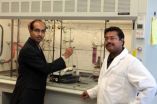Industry collaboration enhances academic science, sociologist finds
2010-12-10
(Press-News.org) New research suggests that private industry and academic science pursue different goals with different consequences, but that the two can still be complementary.
Over the past three decades, private funding and collaboration in university-based research has risen steadily. That has led to concerns about the independence and integrity of public science. However, University of Chicago sociologist James Evans finds that industry can advance academic science by shaking up its conservative nature and encouraging novel discovery.
Evans's research, released today in the American Journal of Sociology, focuses on the science surrounding Arabidopsis thaliana, a flowering plant that has become the dominate genetic model in plant and agricultural sciences. Evans looked at over 18,000 research articles involving Arabidopsis, mapping out which articles are linked together by common research themes, methods, or citations. He could then compare those data to funding sources for each article.
The results show that government-funded studies tended to cluster around related themes and theoretical hubs. Industry-funded work on the other hand tended to stray more from hubs and explore novel gene combinations, use new techniques, or investigate previously unexplored biological processes. "For the network of scientific ideas surrounding Arabidopsis, industry sponsorship weaves discoveries around the periphery into looser, more expansive knowledge," Evans writes. In short, industry pushes scientists "to know less about more."
The findings make sense considering the differing motivations of academic and industry science, Evans argues. Most academic science is incremental and theory-driven. Because government grant money is dispensed by scientists' peers, scientists have little incentive to step outside existing theoretical frameworks. Industry on the other hand rewards new (and potentially profitable) discoveries. It cares little for theory explaining those discoveries. As such, industry encourages innovation by "infusing the pool of theory-driven experiments with unanticipated questions and answers," Evans said.
There's a danger, as government support for science wanes, that the scale could tip too far, at the cost of deep theoretical understanding and the methodical, confirmatory process that is the hallmark of university science, Evans says. But in general, his analysis paints a complementary picture of the two enterprises.
"Governments reward replication; companies enable novelty. Governments sponsor refinements in the thick of existing hubs of scientific activity; industry patronizes pioneering activity into unknown, sometimes desolate, scientific territory."
###
James A. Evans, "Industry Induces Academic Science to Know Less about More." American Journal of Sociology 166:2.
Established in 1895 as the first U.S. scholarly journal in its field, the American Journal of Sociology remains a leading voice for analysis and research in the social sciences. The journal presents pathbreaking work from all areas of sociology, with an emphasis on theory building and innovative methods.
END
ELSE PRESS RELEASES FROM THIS DATE:
2010-12-10
OAK RIDGE, Tenn., Dec. 9, 2010 -- A quicker and cheaper technique to scan molecular databases developed at the Department of Energy's Oak Ridge National Laboratory could put scientists on the fast track to developing new drug treatments.
A team led by Jerome Baudry of the University of Tennessee-ORNL Center for Molecular Biophysics adapted a widely used existing software to allow supercomputers such as ORNL's Jaguar to sift through immense molecular databases and pinpoint chemical compounds as potential drug candidates.
The research was published in the Journal of ...
2010-12-10
Used in the proper amounts, it can make teeth stronger and aid in the treatment of osteoporosis. When excessive amounts are consumed, however, it can be a killer — a carcinogen that causes bone, lung and bladder cancers. The "it" is fluoride, a common additive in most American communities' drinking water and an ingredient in the vast majority of commercially produced adult toothpastes.
Determining the level of fluoride, be it in water, consumer products or the human body, is an important and attractive challenge for scientists. To address that, a Florida State University ...
2010-12-10
A collaborative, government-led effort to guide and standardize diagnosis, treatment and management of food allergies has resulted in the release of an official set of recommendations for physicians.
The guidelines are being published online this week by the Journal of Allergy and Clinical Immunology (JACI), and available online at www.niaid.nih.gov/topics/foodallergy/clinical/Pages/default.aspx. They were developed by the National Institutes of Health and leading researchers and clinicians, professional and patient advocacy organizations, and the American Academy of ...
2010-12-10
Shootings like the one in which a gunman shot a doctor and killed a patient at The Johns Hopkins Hospital in September are "exceedingly rare," but the rate of other assaults on workers in U.S. health care settings is four times higher than other workplaces, conclude two Johns Hopkins emergency physicians after reviewing workplace violence in health settings.
The rate of assault in all private-sector industries in the United States is two per 10,000, compared to eight per 10,000 at health care workplaces, note Gabor D. Kelen, M.D., and Christina L. Catlett, M.D., in a ...
2010-12-10
Using buprenorphine instead of methadone — the current standard of care — to treat opioid-dependent pregnant women may result in healthier babies, suggests new findings from an international team led by Johns Hopkins researchers and published in the Dec. 9 issue of the New England Journal of Medicine.
Babies born to mothers taking buprenorphine instead of methadone to counter heroin and/or prescription opioid addiction were likely to need less morphine to deal with drug withdrawal symptoms, spent half as much time in the hospital after delivery and recovered from neonatal ...
2010-12-10
Johns Hopkins scientists have identified a previously unrecognized step in the activation of infection-fighting white blood cells, the main immunity troops in the body's war on bacteria, viruses and foreign proteins.
"It's as if we knew many of the generals, colonels and majors and now we have discovered a new officer that helps the troops carry out the right battle plan," says Joel Pomerantz, Ph.D., an assistant professor of Biological Chemistry in the Institute for Basic Biomedical Sciences and member of the Institute for Cell Engineering at Johns Hopkins.
The discovery, ...
2010-12-10
A myriad of inputs can indicate a body's health bombard pancreatic beta cells continuously, and these cells must consider all signals and "decide" when and how much insulin to release to maintain balance in blood sugar, for example. Reporting in Nature Chemical Biology last month, researchers at the Johns Hopkins University School of Medicine have teased out how these cells interpret incoming signals and find that three proteins relay signals similar to an electrical circuit.
"Pancreatic beta cells are influenced by hormonal, metabolic and electrical signals and something ...
2010-12-10
Using a new gene sequencing method, a team of researchers led by scientists from Johns Hopkins and the National Institutes of Health has discovered a gene that appears to cause some instances of familial amyotrophic lateral sclerosis (ALS). The finding could lead to novel ways to treat the more common form of this fatal neurodegenerative disease, which kills the vast majority of the nearly 6,000 Americans diagnosed with ALS every year.
Researchers don't know exactly what causes ALS, which destroys the motor neurons that control the movement of all the body's muscles, ...
2010-12-10
Whether in a hurricane, tornado, or bomb attack, a leading cause of injury and death is often fast-flying shards of glass. Explosions and high winds can cause windows in buildings to shatter-spewing jagged pieces of glass in every direction.
A Pentagon report on the 1996 Khobar Towers bombing in Saudi Arabia, for example, noted:
Two of the 19 deceased had injuries know to be caused by glass fragments that were severe enough to cause death even without other contributing forces. Of the remaining 17 deceased, 10 had glass injuries that were significant and which may ...
2010-12-10
Although presidents at some U.S. colleges have argued that lowering the minimum legal drinking age could help curb binge drinking on campuses, a new study in the January issue of the Journal of Studies on Alcohol and Drugs suggests such a measure would be ineffective.
In 2008, a group of college presidents and chancellors formed the Amethyst Initiative, a call to rethink the current minimum legal drinking age of 21. They argue that the law encourages underage college students to drink at parties, where binge drinking is common. The main argument states that if students ...
LAST 30 PRESS RELEASES:
[Press-News.org] Industry collaboration enhances academic science, sociologist finds

